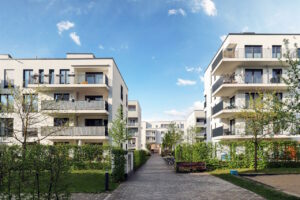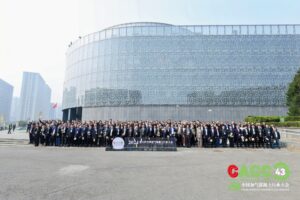Manifesto for the Urban Transformation Campaign
The European Green Deal aims to integrate climate and environmental action across all policy areas and simultaneously spur growth for Europe’s economy, turning sustainability into a competitive advantage. Despite the profound change that the construction sector will have to undergo to comply with these objectives, we believe that the Green Deal will help transform our urban areas into thriving environments where humans and nature can co-exist in a sustainable manner.
The Urban Transformation Campaign is EAACA’s commitment to transforming urban spaces by tackling key challenges, such as climate change, progressive urbanisation, low quality post-war housing, ageing societies, environmental degradation and digitalisation.
the Manifesto Urban Transformation Campaign of EAACA here
the Infographic Urban Transformation Campaign of EAACA here
Environment
If the appropriate policy measures are taken, the European construction industry can contribute to the environmental efforts of the Green Deal and become the leading industry for sustainable resource management. Integrating circular economy principles across the sector will be vital to keep valuable resources in the system.
- The Circular Economy Action Plan seeks to establish full circularity in construction. It can help improve material efficiency in the sector by emphasizing the circularity credentials of specific materials and construction products of choice for both renovation and new build. The sustainable product framework initiative, a key piece of the Circular Economy Action Plan, has to consider a sustainable construction product design, that implies strong but lightweight and easy-to-use products, which are fit for outdoor and indoor purposes and are made from natural resources.
- Revising the Construction Products Regulation needs to set appropriate standards to ensure reduction of raw material inputs and thus a sustainable management of materials. This can lead to crucial energy savings over a building’s life cycle, while simultaneously safeguarding quality levels.
- We require a full life-cycle assessment of construction products instead of focusing only on embedded energy. The Level(s) framework needs to be incorporated into legislation to improve re-use and recycling in the sector.
- A reform of the current waste legislation framework and establishment of circularity targets in the EU Construction and Demolition Waste Management Protocol are required. Waste management within the construction industry needs a timely and adequate collection and recycling infrastructure for both closed and open loop recycling.
Carbon footprint
Reducing the carbon footprint of Europe’s building stock in order to achieve the overarching goals of the Green Deal requires a holistic approach with differentiated implementation to ensure maximum impact.
- The proposal for an EU Climate Law includes a net-zero emissions target by 2050. For the construction sector, this implies a move from the nearly zero to a net zero emissions target for Europe’s building stock. Buildings still account for the biggest share (40%) of total EU energy consumption and produce about 35% of all greenhouse gas emissions. Achieving this target can only be envisioned when complementarity of energy performance measures is promoted, and through a focus on net-zero energy districts and integration of on-site renewable energy units.
- The Renovation Wave Initiative will play an important role in delivering on the energy efficiency targets for buildings. The key objective for the European Commission is to at least double or even triple the renovation rate of buildings, which currently stands at around 1.3%. However, we cannot depend on renovation alone, considering this low annual renovation rate and the quality of Europe’s post-war building stock. We should also set incentives to renew buildings through a complementary investment plan for more long term building replacement. Demolition and new build can ensure a state-of-the-art energy performance which is not always possible when upgrading old building stock, as well as allow for building design to be tailored to the needs of inhabitants.
Competitiveness
The European construction industry is a cornerstone of the European economy and driver for investment, jobs and innovation. It provides essential infrastructure, goods and services for everyday life. Political support for the European construction industry will be vital to ensure that it can continue to provide these basic services.
- If we want to safeguard our existing industries and jobs on the long-term, while creating new ones in the process, the EU’s industrial strategy needs to set a smart, flexible and cohesive policy framework that prevents burdensome legislation for the construction sector.
- The future work of the Commission on competitiveness has to acknowledge that more needs to be done to boost the construction sector. In populous urban areas, there is a growing need for affordable housing across EU member states. EU legislation can provide solutions to this crisis, for example by providing better financial instruments to promote investments into buildings.
Connectivity
In 2050, more than two thirds of the global population will live in cities. While this unprecedented urbanisation will bring many challenges, we believe that Europe can use this as an opportunity to create sustainable and smarter living environments through the integration of transport, energy and ICT systems. For the construction sector, digitalisation will bring important benefits such as time-savings and a significant increase in productivity and accuracy.
- The Commission’s data strategy needs to increase digital efforts for construction. The strategy highlights several digital innovations that will define buildings in the future: energy efficiency can be significantly improved through smart applications in buildings, data volumes are growing and data gathered for example through smart meters or smart home appliances will change the roles of buildings, particularly in urban networks. Tools such as Building Information Modelling (BIM) can for instance incorporate environmental data in building planning which is valuable in scope of a building’s entire life cycle.
- The strategy for sustainable and smart mobility also should recognize the importance of buildings in the context of more connected urban spaces. We need to focus on net-zero energy districts over building units to ensure the complementarity of energy performance measures.
- The integration of buildings into energy and electric vehicle charging infrastructure will be crucial to energy- and space-efficiency in cities. We should further focus on achieving more cost-optimal solutions by incentivising on-site renewables in net-zero houses over passive housing.
Download
the Manifesto Urban Transformation Campaign of EAACA here.
the Infographic Urban Transformation Campaign of EAACA here
Do you want to become a member of EAACA? Contact us!
News

Highlights of the EAACA Net-Zero Roadmap for the Autoclaved Aerated Concrete Industry
Toward a Climate-Neutral Future: Highlights of the EAACA Net-Zero Roadmap for the Autoclaved Aerated Concrete Industry The European Autoclaved Aerated Concrete Association (EAACA) has

Sustainable and yet affordable – how AAC manages the balancing act
Since its invention about 100 years ago, autoclaved aerated concrete (AAC) has established itself as a preferred building material in the construction industry in terms

43th China Aerated Concrete Conference
During October 6th to 8th, 20024, China Aerated Concrete Association (CACA) organized 43th China Aerated Concrete Conference in the old heritage city Xi’an with the
